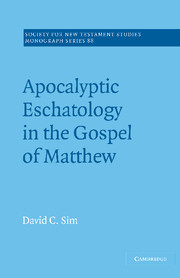Book contents
- Frontmatter
- Contents
- Preface
- List of abbreviations
- Introduction
- Part I Apocalyptic eschatology and apocalypticism
- Part II Apocalyptic eschatology in the gospel of Matthew
- 3 Dualism and determinism in Matthew
- 4 Eschatological woes and the coming of the Son of Man in Matthew
- 5 The judgement in Matthew
- 6 The fate of the wicked and the fate of the righteous in Matthew
- 7 The imminence of the end in Matthew
- Summary of Part II
- Part III The social setting of the Matthean community and the function of apocalyptic eschatology in the gospel of Matthew
- Conclusions
- Select bibliography
- Index of passages cited
- Index of modern scholars
- Index of subjects
6 - The fate of the wicked and the fate of the righteous in Matthew
Published online by Cambridge University Press: 04 November 2009
- Frontmatter
- Contents
- Preface
- List of abbreviations
- Introduction
- Part I Apocalyptic eschatology and apocalypticism
- Part II Apocalyptic eschatology in the gospel of Matthew
- 3 Dualism and determinism in Matthew
- 4 Eschatological woes and the coming of the Son of Man in Matthew
- 5 The judgement in Matthew
- 6 The fate of the wicked and the fate of the righteous in Matthew
- 7 The imminence of the end in Matthew
- Summary of Part II
- Part III The social setting of the Matthean community and the function of apocalyptic eschatology in the gospel of Matthew
- Conclusions
- Select bibliography
- Index of passages cited
- Index of modern scholars
- Index of subjects
Summary
In the previous chapters, it was argued that Matthew combined his Christian and Jewish sources to arrive at a distinctive portrayal of Jesus as the saviour figure, the Son of Man. The Son of Man will return in glory with his angelic army, and will then sit upon his glorious throne to preside over the final judgement. As the one who sits in judgement, it is Jesus the Son of Man who dispenses eschatological rewards and punishments. As we would expect from an author for whom the judgement is paramount, Matthew devotes a considerable amount of space to each category. In relation to this subject, it is important to note that there is no hint in Matthew that the wicked dead or the righteous dead receive a sample of their respective eschatological fates in the intermediate period between death and the final judgement. While such an idea is found in later Jewish apocalyptic eschatology and is prominent in other New Testament writings, particularly the gospel of Luke (16:19–31;23:43), it seems to play no part in Matthew's apocalyptic-eschatological scheme. This means that all emphasis falls on the final judgement and its aftermath.
The fate of the wicked
Matthew has a good deal to say about the ultimate fate of the wicked. The picture he presents is not a pretty one and is in fact among the most severe of the apocalyptic-eschatological schemes of his time. There are references of a general nature which state that the wicked will meet with condemnation (12:41–2), destruction (7:13) and eternal punishment (25:46), but more revealing than these are his specific statements about the fate of the wicked.
- Type
- Chapter
- Information
- Apocalyptic Eschatology in the Gospel of Matthew , pp. 129 - 147Publisher: Cambridge University PressPrint publication year: 1996

